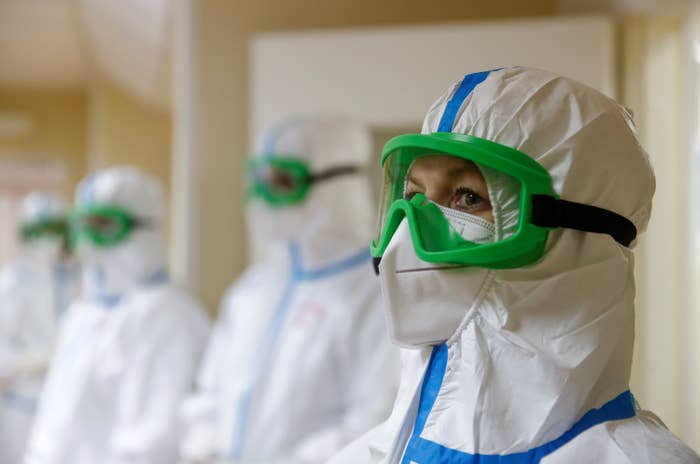"The traditional means of protesting, gathering friends together, is unsafe at this time, so our protest looks like a car caravan."
Amber JamiesonBuzzFeed News Reporter Posted on May 1, 2020
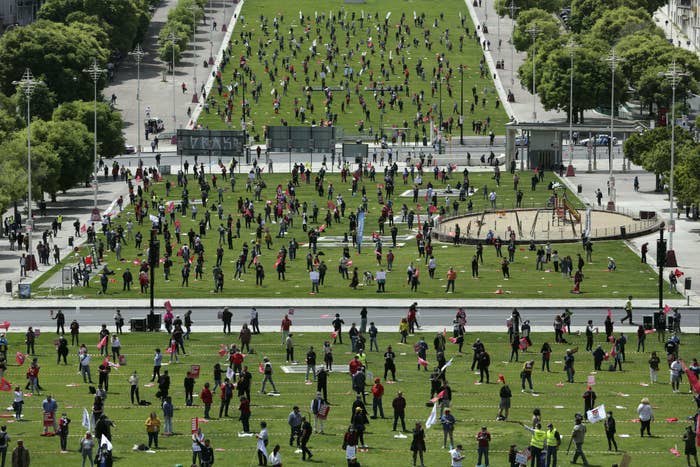
Armando Franca / AP
Workers unions keep a safe distance from each other and wear face masks to help protect against the spread of the coronavirus in Lisbon, May 1.
Essential workers led hundreds of May Day protests on Friday, including nurses calling for better protective gear in hospitals and Amazon workers holding walkouts to demand closures of warehouses where staffers are infected with COVID-19.
But how do you protest during a global pandemic, when social distancing is crucial and a lack of protective gear is a key demand of workers?
May 1 is historically the biggest protest day for the labor movement, with large rallies held across the globe. With over 30 million US workers filing for unemployment since the pandemic began, and essential workers risking their lives for company profits, advocates say this year's protests felt even more vital.
However, protests looked different this year. On social media, thousands of people shared posts calling for a one-day boycott of Walmart, Instacart, Amazon, Whole Foods, Target, and Shipt.
But how do you protest during a global pandemic, when social distancing is crucial and a lack of protective gear is a key demand of workers?
May 1 is historically the biggest protest day for the labor movement, with large rallies held across the globe. With over 30 million US workers filing for unemployment since the pandemic began, and essential workers risking their lives for company profits, advocates say this year's protests felt even more vital.
However, protests looked different this year. On social media, thousands of people shared posts calling for a one-day boycott of Walmart, Instacart, Amazon, Whole Foods, Target, and Shipt.

#PettyPendergrass@ashoncrawley
boycott walmart, amazon, fedex, whole foods, target, shipt and instacart tomorrow, may 1, 2020. stand with the workers that deserve better pay and safe working conditions.02:33 AM - 01 May 2020
Fewer protests are in person on the street, and those that are involve attendees standing 6 feet away from each other. Others are using car caravan protests, which have become popular since the pandemic began, including groups ranging from those calling for government lockdowns to end and supporters of California's farmworkers.
"Some of these social distancing protests are quite dramatic and quite powerful," said Ray Brescia, professor of law at Albany Law School and author of The Future of Change: How Technology Shapes Social Revolutions. He likened the creativity of the May Day protests to the AIDS Memorial Quilt.
Angela Gatdula, a nurse working in a COVID-19 ward at Providence Saint John's Health Center in Santa Monica, California, spoke to BuzzFeed News over the honks from the car caravan, which she organized with other unionized nurses from National Nurses United and the California Nursing Association.
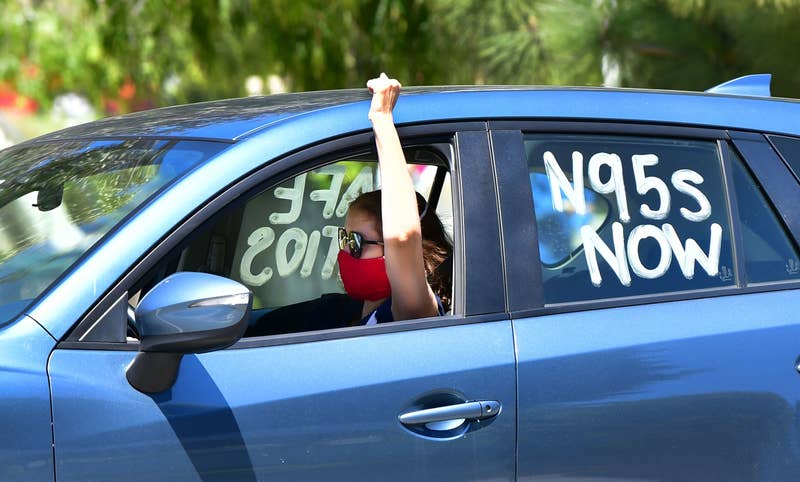
Frederic J. Brown / Getty Images
Nurses employed at Providence Saint John's Health Center and their supporters participate in a car caravan in Santa Monica, California, April 21.
"The traditional means of protesting, gathering friends together, is unsafe at this time, so our protest looks like a car caravan," said Gatdula, who got sick with COVID-19 while treating patients.
They had gathered at a nearby parking lot and planned to drive in laps around the hospital, honking their horns and displaying messages painted on their windshields and on posters being held out of windows.
"We can't get PPE," Gatdula said, referring to personal protective equipment.
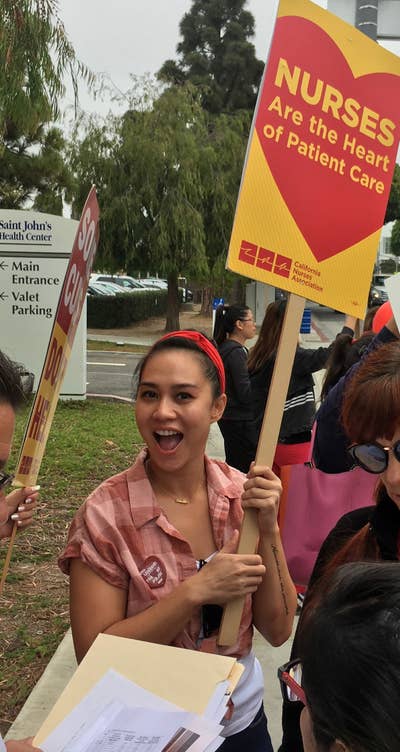
California Nurses Association / National Nurses United
Angela Gatdula
She noted that her hospital makes them reuse N95 masks. A group of nurses from her hospital were suspended — and later reinstated — after refusing to treat patients without the masks.
They want the Occupational Safety and Health Administration to order a temporary emergency order to protect and give optimal PPE to health care workers, and for the president to fully enact the Defense Production Act to increase the production of PPE.
"I'm doing everything I can, and hopefully that pushes our hospital administrators, legislators, and the president to do the right thing and get us the protection we need to keep ourselves safe and the community safe," Gatdula said.
For weeks, nurses across the country have been participating in shift change protests calling for better PPE, wherein at the end of one shift nurses walk outside hospitals and speak to the media about their need for N95 masks as the new group takes over caring for patients.
Brescia pointed out the effectiveness of health care workers who have posted videos of themselves on social media showing bruises from wearing masks all day and crying at the horrors of what they've seen as a form of protest.
"I’m fully confident some of these images and messages from inside the hospital wards have gotten people to stay at home," he said. "People are using creative ways to connect and capture the reality of the ground for so many and getting it out to people who are going to be affected by it and can advocate for change."
Make the Road New York — which advocates for immigrants and working-class communities — organized a car caravan through the streets of Midtown Manhattan, starting at Gov. Andrew Cuomo's office, moving to Times Square, where they protested with body bags, and ending at the luxury NoMad apartments of Amazon boss Jeff Bezos, where a mariachi band played.
"This situation is going to call for artists and creative types to embrace the restrictions and find ways to communicate the need for change in new ways," Brescia said.
In 2019, the organization's May Day protest had been a march through the downtown financial district. But organizers realized that this year their normal plans would not work, and they tried to figure out "what we could pull off," said Jose Lopez, deputy director of Make the Road New York.
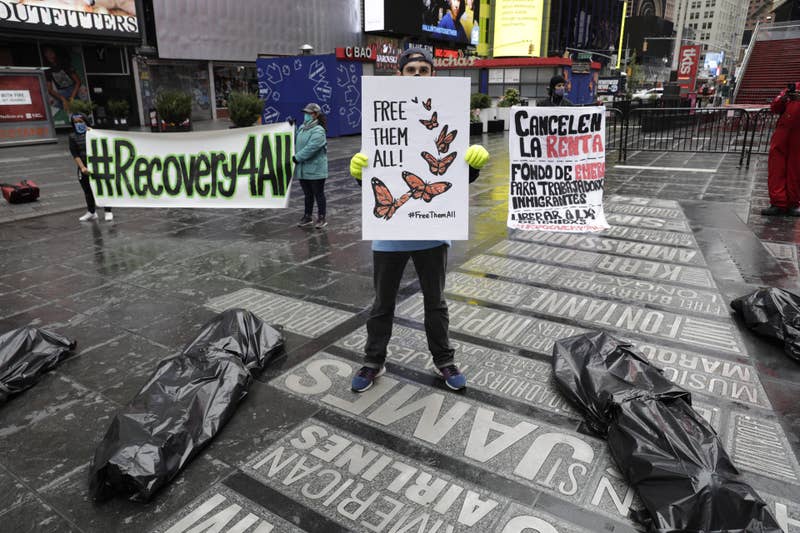
Make the Road New York
A protester with Make the Road New York holds a May Day demonstration in Times Square.
The group is calling for a $3.5 billion state bailout for excluded workers, including those who are undocumented, a cancellation of rent and mortgage payments, and the release of people from immigration detention centers and prisons.
"We all kind of got on a phone call and hashed out some ideas and spitballed some plans that we thought we would be creative and cool," Lopez said.
Car protests don't usually take place in New York City, an area with low car ownership. Lopez said they sent out requests to staff and members to see who had access to vehicles to ensure they would have at least 50 available.
They then encouraged people to make signs and decorate their vehicles. They provided guidance on how to maintain social distancing for moments when people got out at the stops to play music and hold posters; they also included guidelines to make sure cars stayed in a single file line in order not to block roads and delay any EMS workers.
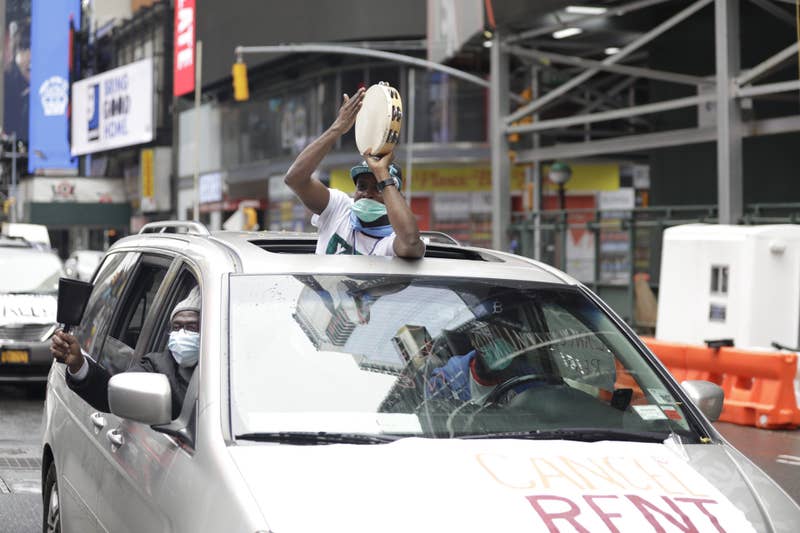
Make the Road New Yor
A protester in the Make the Road New York car caravan, May 1.
Protesters were asked not to bring anyone with them who does not already live in their home — "something we would never do for a street-based action," Lopez said. "It was the opposite of what I would normally do, which would be [to] say, 'bring your whole building with you!'"
They also organized a Facebook Live panel, run by two moderators at home, to ensure members who did not have access to a car or were at high risk of getting ill could participate.
Former Amazon worker Christian Smalls, who was fired in recent weeks after organizing a walkout over working conditions at the company's Staten Island warehouse, led a small socially distanced protest with other essential workers in New York City.

Christian Smalls@Shut_downAmazon
2nd Stop @NYGovCuomo Office 💪🏽07:55 PM - 01 May 2020
Reply Retweet Favorite
May Day protests look different in 2020, particularly since most essential workers are avoiding the tactics of armed demonstrators in Michigan's capitol this week, but they can be an effective tool for calling for workers' rights, Brescia said.
"If people were able to protest the federal government’s response to COVID, you would see ... [rallies] multiple times the size of the Women's March in every city, if people were able to demonstrate," he added. "You can still demonstrate, and you have to use the protections, and I think it’s very powerful when people do that."
